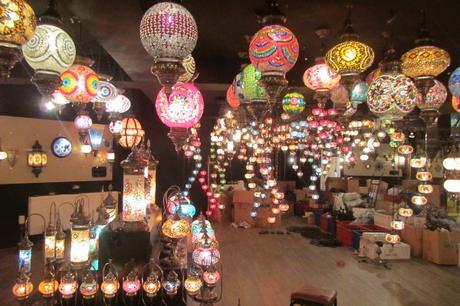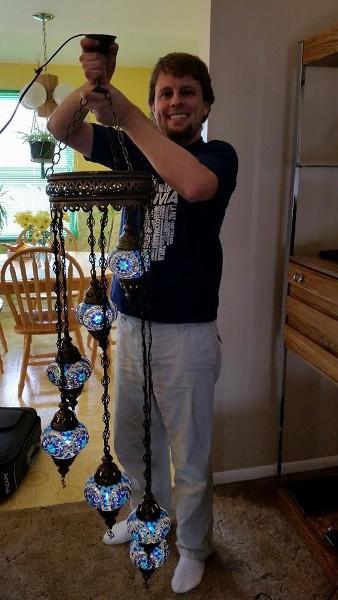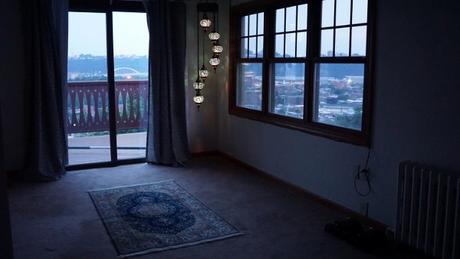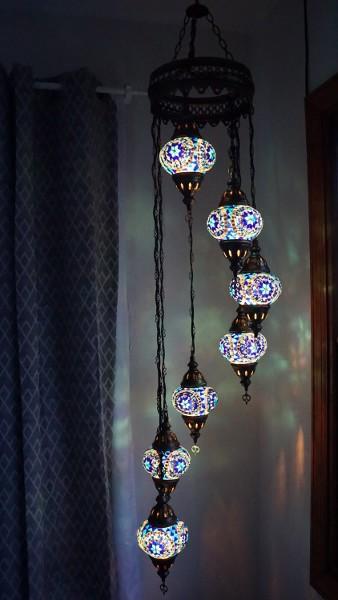 If you've ever visited Istanbul, you'll no doubt have seen hundreds upon hundreds of the gorgeous and ornate Turkish lamps that are found throughout the city. Our first thought was that these lamps were pretty awesome, and without hesitating we began a quest to to buy one for our (at the time) future home.
If you've ever visited Istanbul, you'll no doubt have seen hundreds upon hundreds of the gorgeous and ornate Turkish lamps that are found throughout the city. Our first thought was that these lamps were pretty awesome, and without hesitating we began a quest to to buy one for our (at the time) future home.
This was all well and good, but there was one problem: we had no idea how to make it work when we got home.
Luckily for us, modifying the lamp turned out to be incredibly easy, and you don't have to be an engineer with an electrician for a father to figure it all out (that being said, I'll give you one guess which category we fell into). But if you have reservations about making your Turkish lamp working at home, this step-by-step guide is all you need to take your boxed up lamp and turn it into the star attraction of a room!
Step 1 - The Bulb Sockets Aren't the Same
The main problem with European lamps as compared to American lamps is that the socket sizes are not the same. Our Turkish lamp uses European E14 candelabra bulbs with a socket of 14 mm width. American candelabra bulbs on the other hand are only 12mm wide (known as E12).
When we first screwed a bulb in and turned it on we didn't know this. The bulb went too far down into the socket and short circuited. The bulb burnt out, there was a spark, and we melted a piece of metal on the inside of the socket.
Oops - not a good first test. (I said I was an engineer, I never said I was skilled in electricity.)
After realizing our mistake and performing a quick search online, we found candelabra adapters to reduce E14 sockets to E12 for just $1.50 each. Apparently we were not the first people with this problem and the internet saved us on our first step. We bought a ten pack on Amazon ( get yours here
Step 2 - Don't Go for High Wattage Bulbs

Now that you can get your bulbs screwed in, the next step is to ensure you use the right bulbs and don't burn your house down. No pressure.
This is pretty crucial as high wattage bulbs will risk overloading the amperage draw on the wires. Doing so may cause the wires to overheat and possibly catch fire. But as it turns out, this is pretty easy to avoid.
The equation that dictates how much amperage you'll draw is Ohm's Law. It is simply this:
Amps = Power (Watts) / VoltageTake the power of the bulb in Watts, divide it by the Voltage (for American houses it is 120 V), and you'll get the amperage draw in one light socket in your lamp. Add it up for all the bulbs in your lamp to get the total draw across the common wire and that is all you need.
After calculating this number, you'll then want to compare it to the amperage rating of the wire base on its gauge size, and ensure you are nowhere near that maximum capacity (I've read that 80% is a safe figure, but for home made customizations it is good to be as low as possible).
Unfortunately for Turkish lamps like ours, there are seven bulbs which connect into a single cable, so you have two issues to consider.
- The amperage in each individual line.
- The amperage drawn on the combined line going into the wall.
Assuming both wires are the same gauge size, your amperage draw will be limited based on the cumulative total from all the bulbs. As ours had seven, we had to look at the calculation like this:
Amps = Power / Voltage * 7Using 4W candelabra bulbs, we were pulling 0.23 Amps across the main wire, and 0.03 Amps across the individual wires leading down to the bulbs themselves. With an overall rating estimate of about 7-10 Amps for the wire (based on estimated gauge size), we're nowhere near capacity. But if you put in 120W bulbs, you can see that you're getting close.
Overall, with the number of modifications you're making past the factory designed settings, it is probably a good idea to be as far away from the rated figure as you can. Luckily 4W bulbs look great, and since you're not using the lamp to light a room you should be fine. (Although with any home modification that hooks up to electricity, you probably don't want to run it when you're not there either way).
Note - If your lamp has any electronics attached to it like a dimmer you may have to make more modifications as those may not play well with US voltages.
Step 3 - Alter the Cord Length and Hang


When it comes to hanging a Turkish lamp, we're not experts. We got very lucky in that the maintenance team for the house we are renting was able to hang it for us without issue. Our seven bulb lamp did not require any special insets into the wall as there was a rather robust wood beam for it to screw into in the exact spot we wanted to hang it.
Past here, for significantly heavier lamps or odd placements, you may want to look into a chandelier brace
Other than physically hanging the lamp, which we hope will be an easy task for your situation, you will likely have to extend the wire leading to the nearest electrical outlet. For us this meant buying a few items from our local hardware store:
- 18 gauge electrical wire (gauge should match the lamp's specific wiring).
- Wire nuts.
- Electrical tape (although we decided not to use it).
- A wire-to-wall plug.
- Wire conduit or other adhesive to affix the cord into place.
This task is pretty simple as you have to strip the wire, connect the extension to the corresponding wires, and use the wire nuts and wall plug to lock it all in place.
As there are numerous guides out there on the internet on how to do this, we're not going to reinvent the wheel here. Our only recommendation would be to get a wall plug with a big enough opening for the electrical wire, as many exist with smaller openings that larger gauge wires do not fit into (not that this happened to us or anything...).
After that you are good to go and a new, and awesome, Turkish lamp will be yours to enjoy!

